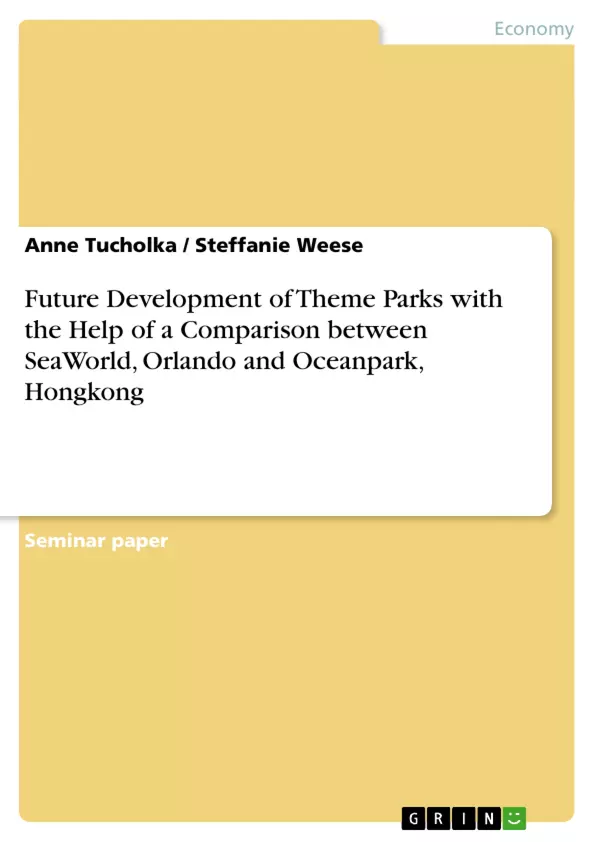A theme park is an amusement park in which all the settings and attractions have a central theme, such as the world of the future. So the question is how an amusement park is defined.
It is a commercially operated park offering various forms of entertainment, such as arcade games, carousels, roller coasters, and performers, as well as food, drink, and souvenirs. Amusement parks differ from circuses, carnivals, and world's fairs (see exposition) in that, parks are permanently located entertainment complexes, open either all year or seasonally every year. In today’s theme parks more or less exotic worlds which do not exist in reality are staged on a delimited area as a setting for entertainment (cp. Stemshorn 2000, p.9). A huge number of leisure opportunities are packaged within a theme park and serve as a contrast to everyday life (cp. Opaschowski 1998, p.24 et seq.). They are characterized by following features: # Sophisticated, extensive services for different target groups # Extensive and differentiated gastronomic offers; # all inclusive entertainment range # Continuity and change # Usage of marketing instruments like special prices or special offers, joint venture or special offers for target groups; # Possibilities for overnight stays by integrated or nearby situated hotels; # Perfection and professionalism as quality mark; intensive training of staff; # Attractions: the general range of attractions includes rides with a lot of thrill, nostalgic carousels, clowns, shooting galleries and so on; # Artists, stunt- shows, music- shows, parades, animal- shows, firework and more. (www.kuwi.uni.linz.ac.at/LehreUniLinz.htm)
On the following pages theses features and some more characteristics of theme parks will be explained in detail by using the two examples "Seaworld, Orlando" and "Oceanpark, HongKong". Questions like "Where are the trends goning?" or "What is special about a modern theme park" will be answered.
Inhaltsverzeichnis (Table of Contents)
- Introduction
- Definition
- Socio-cultural aspects
- Current market situation
- Comparison Sea World, Orlando and Ocean Park, Hongkong
- Sea World
- General Information
- Specials
- Future planning
- Ocean Park
- General Information
- Specials
- Future planning
- Comparison
- Similarities
- Differences
- Conclusion
- Sea World
- Future Development
- General trends
- Criticism and risks
- Summary
Zielsetzung und Themenschwerpunkte (Objectives and Key Themes)
This paper aims to analyze the future development of theme parks by comparing two prominent examples: SeaWorld in Orlando and Ocean Park in Hong Kong. The study explores the socio-cultural and economic factors that influence the theme park industry, examining how parks adapt to changing consumer preferences, technological advancements, and global trends.
- The evolution of theme parks and their role in modern society
- The importance of socio-cultural and economic factors in shaping the theme park industry
- A comparative analysis of two prominent theme parks, SeaWorld and Ocean Park, focusing on their unique offerings and future strategies
- The identification of key trends and challenges facing the theme park industry
- The role of sustainability, technology, and guest experience in future development
Zusammenfassung der Kapitel (Chapter Summaries)
- Introduction: This chapter provides a definition of theme parks, differentiating them from traditional amusement parks and outlining their key characteristics. It then delves into the socio-cultural aspects that drive the theme park industry, highlighting the desire for escapism, entertainment, and immersive experiences. The chapter concludes by analyzing the current market situation, emphasizing the importance of understanding consumer preferences, economic factors, and the changing demographics of the target audience.
- Comparison Sea World, Orlando and Ocean Park, Hongkong: This chapter presents in-depth analyses of two prominent theme parks, SeaWorld in Orlando and Ocean Park in Hong Kong. It examines their general information, including location, history, and target audience, and delves into their unique special offerings and future plans. The comparison highlights similarities and differences between the two parks, examining their strategies for attracting visitors and navigating industry trends.
- Future Development: This chapter explores the key trends and challenges facing the theme park industry. It discusses the growing emphasis on sustainability, the increasing importance of technology, and the ongoing need to innovate and create unique guest experiences. It also addresses the potential risks and criticisms associated with the theme park industry, such as animal welfare concerns and environmental impact.
Schlüsselwörter (Keywords)
This paper focuses on key terms and concepts related to the theme park industry, including: theme park, amusement park, socio-cultural aspects, market situation, consumer preferences, economic factors, SeaWorld, Ocean Park, sustainability, technology, guest experience, future development, trends, challenges, criticism, and risks.
- Quote paper
- Anne Tucholka (Author), Steffanie Weese (Author), 2006, Future Development of Theme Parks with the Help of a Comparison between SeaWorld, Orlando and Oceanpark, Hongkong, Munich, GRIN Verlag, https://www.grin.com/document/63024



